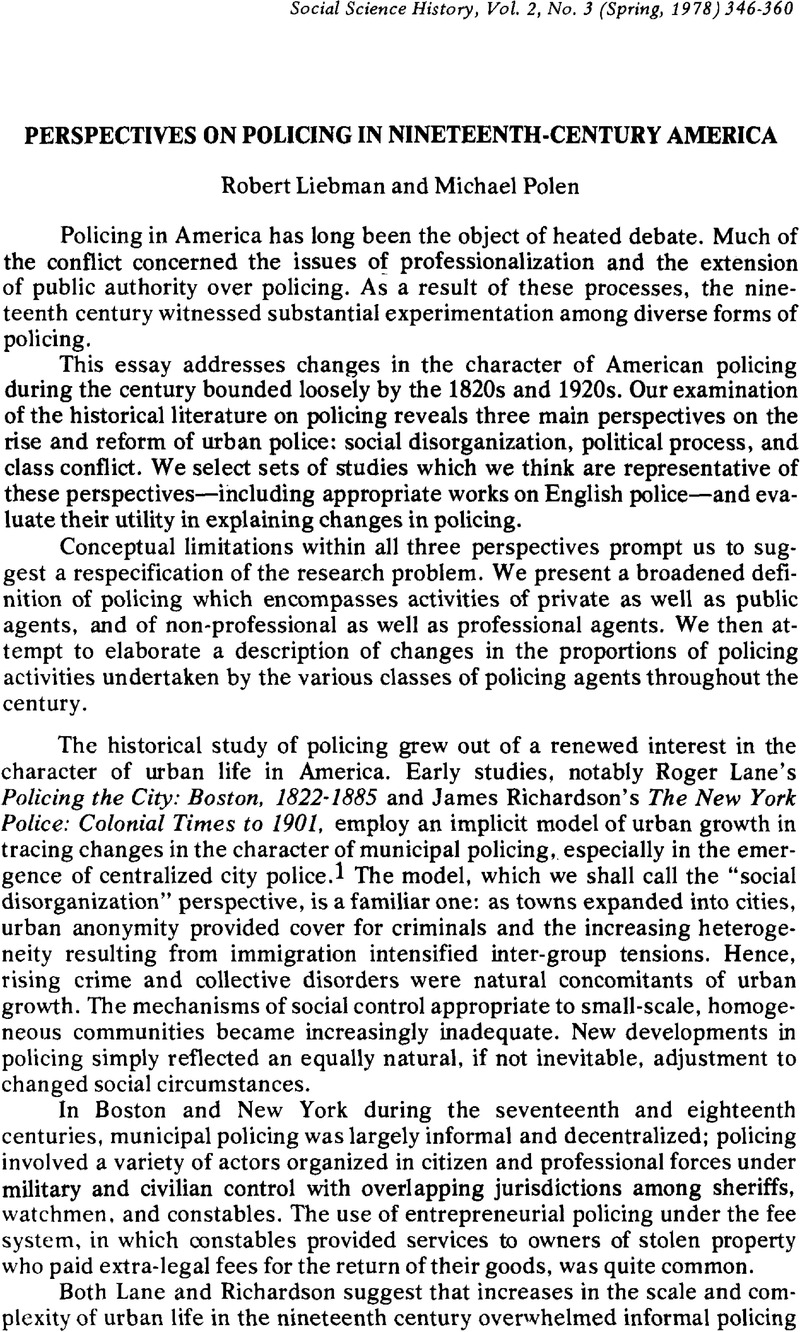Article contents
Perspectives on Policing in Nineteenth-Century America
Published online by Cambridge University Press: 04 January 2016
Abstract

Information
- Type
- Review Essays
- Information
- Copyright
- Copyright © Social Science History Association 1978
References
Notes
1 Lane, Roger, Policing the City: Boston, 1822–1885 (Cambridge, Mass., 1967)CrossRefGoogle Scholar; Richardson, James F., The New York Police: Colonial Times to 1901 (New York, 1970)Google Scholar.
2 Lane, Roger, Policing the City, 221.Google Scholar
3 Richardson, James F., The New York Police, 25.Google Scholar
4 Ibid., 22, 24-25.
5 Richardson, James F., Urban Police in the United States (Port Washington, New York, 1974), 19.Google Scholar
6 Lane, Roger, Policing the City, 26.Google Scholar
7 Levett, Allan E., “Centralization of City Police in the Nineteenth Century United States” (Ph.D. dissertation, Department of Sociology, University of Michigan, 1975)Google Scholar.
8 Ibid., 18.
9 See for example, Dawley, Alan, Class and Community (Cambridge, Mass., 1976), chapter four.Google Scholar
10 Walker, Samuel, A Critical History of Police Reform: The Emergence of Professionalism (Lexington, Mass., 1977)Google Scholar. Big-City Police (Cambridge, Mass., 1977) by Robert M. Fogelson covers much the same ground, although it pursues the theme of police reform into the 1970s.
11 Samuel Walker, A Critical History, 3.
12 Ibid., 31.
13 See Center for Research on Social Justice, The Iron Fist and the Velvet Glove: An Analysis of the U. S. Police (Berkeley, 1975)Google Scholar; Harring, Sidney L. and McMullin, Lorraine M., “The Buffalo Police 1872–1900: Labor Unrest, Political Power and the Creation of the Police Institution,” Crime and Social Justice, 4 (Fall-Winter 1975), 5–14Google Scholar; Harring, Sidney, “The Development of the Police Institution in the United States,” Crime and Social Justice, 5 (Spring-Summer 1976), 54–59Google Scholar; Dawley, Class and Community, chapter four.
14 Sidney Harring, “The Development of the Police Institution,” 54.
15 Sidney Harring and Lorraine McMullin, “The Buffalo Police.”
16 Silver, Allan, “The Demand for Order in Civil Society: A Review of Some Themes in the History of Urban Crime, Police, and Riot,” in Bordua, David J., ed., The Police: Six Sociological Essays (New York, 1967), 10.Google Scholar
17 Ibid., 13.
18 Ibid., 15.
19 Ibid., 11–12.
20 Storch, Robert D., “The Plague of the Blue Locusts: Police Reform and Popular Resistance in Northern England, 1840–57,” International Review of Social History, 20 (Part 1, 1975), 61–90CrossRefGoogle Scholar; Storch, Robert D., “The Policeman as Domestic Missionary: Urban Discipline and Popular Culture in Northern England, 1850–1880,” Journal of Social History, 9 (Summer 1976), 481–509.CrossRefGoogle Scholar
21 Robert Storch, “The Policeman as Domestic Missionary,” 481.
22 For example, Sidney Harring and Lorraine McMullin, “The Buffalo Police.”
23 Johnson, Bruce C., “Taking Care of Labor: The Police in American Politics,” Theory and Society, 3 (Spring 1976), 89–117.CrossRefGoogle Scholar
24 Ibid., 91.
25 Gutman, Herbert G., “The Worker’s Search for Power,” in Morgan, H. Wayne, ed., The Gilded Age: A Reappraisal (Syracuse, New York, 1963), 38–68Google Scholar; Gutman, Herbert G., “Class, Status and Community Power in Nineteenth Century American Industrial Cities: Paterson, New Jersey: A Case Study,” in Gutman, Herbert G., ed., Work, Culture, and Society in Industrializing America (New York, 1976), 234–60.Google Scholar
26 Bruce C. Johnson, “Taking Care of Labor,” 94–96.
27 For example, Richardson concludes that the New York police “did not identify with the problems and aspirations of labor; nor did labor have any respect for the police” (The New York Police, 201). Only Walker seems impressed by instances in which local police were seen by industrialists as being unreliable during strikes (A Critical History, 76).
28 Under Anglo-Saxon law, citizens were collectively responsible for maintaining public order within their communities. In most American cities, public policing before centralization comprised several roles: nightwatch, constable, day and night police are examples. We use the term “citizen watch” to refer to policing roles that citizens were obliged to perform. Even by the early nineteenth century, the extent of professionalization among the citizen watch varied greatly from place to place.
29 See Brown, Richard M., “The American Vigilante Tradition,” in Graham, Hugh Davis and Gurr, Ted Robert, eds., Violence in America (New York, 1969), 144–218Google Scholar; Brown, Richard M., Strain of Violence: Historical Studies of American Violence and Vigilantism (New York, 1975)Google Scholar.
30 Silver, Allan, “The Demand for Order,” 8.Google Scholar
31 Johnson, Bruce C., “Taking Care of Labor,” 75.Google Scholar
32 Lane, Roger, Policing the City, 55–56.Google Scholar
33 Fosdick, Raymond B., American Police Systems (New York, 1920), 97.Google Scholar
34 Richardson, James F., The New York Police, 104–5Google Scholar; Walker, Samuel, A Critical History, 27–28.Google Scholar
35 Johnson, Bruce C., “Taking Care of Labor,” 93.Google Scholar
36 Walker, Samuel, A Critical History, 76.Google Scholar
37 Ibid., 29; see also Shalloo, J. P., Private Police: With Special Reference to Pennsylvania (Philadelphia, 1933), 58–134.Google Scholar
38 Walker, Samuel, A Critical History, 30–31Google Scholar; Brown, Richard M., Strain of Violence, 134–43.Google Scholar
39 Our account of the political background argues for a national analysis based on a sample of states and localities. Any account should consider regional variations in explanatory variables such as the extent of industrialization and the degree of central political control. We are working on an explanatory perspective and developing strategies for research.
- 2
- Cited by

